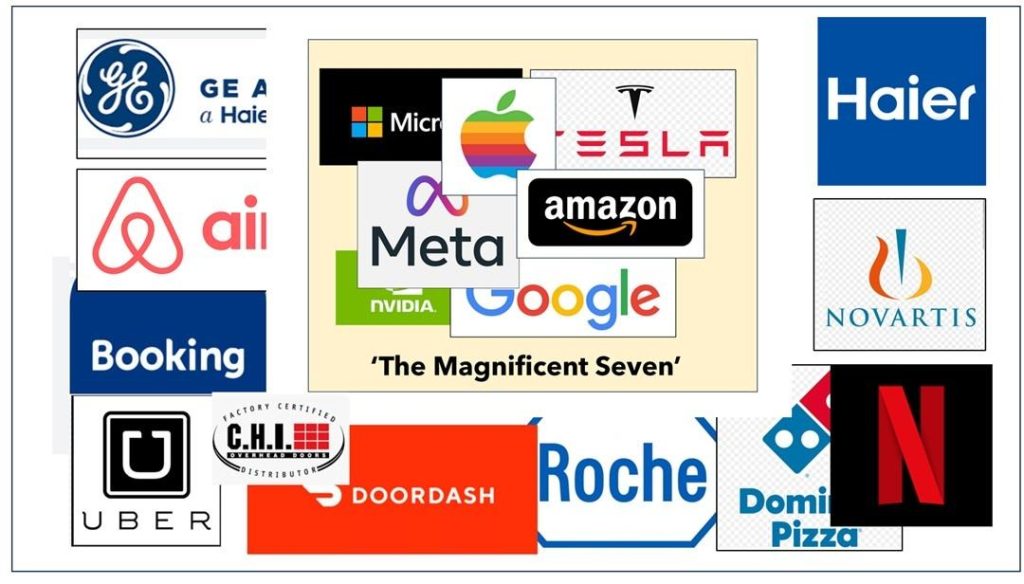When the electrification of factories in the late 19th century made it possible to replace steam power, several decades passed before factory owners thought through, and implemented, the obvious adjustments needed to take advantage of electricity’s greater flexibility. A similar phenomenon is occurring with management in today’s digital age.
Thus, it is conventional wisdom today that the practice of management must change fundamentally to deal with extreme upheavals in digital technology, AI, climate change, and the turbulent world economy. It is much less widely understood that the practice of management has already undergone fundamental change in the most successful firms.
Thus the top seven firms in the S&P500 alone—called the ‘Magnificent Seven’ by CNBC analyst, Jim Cramer—now have a combined market capitalization of $11 trillion and represent 30% of the total market capitalization of the entire S&P500. And while another swathe of firms is on a similar transformation track—perhaps 20% of the total number of firms in the S&P500—the bottom 80% of firms in the S&P500 still cling to traditional management practices and fall steadily further behind.
What Is Digital-Age Management?
While there are variations among individual firms, the overall pattern of digital-age management across many firms is becoming increasingly clear, as shown in Figure 2. It is in many ways the opposite of industrial-era management.
The digital-age management pattern isn’t a secret. Individual firms have been written about by practitioners such Satya Nadella (Microsoft), Colin Bryar and Bill Carr (Amazon) and Curt Carlson (SRI International); distinguished analysts such as Rita McGrath, Joe Pine, Annika Steiber, and Steven Kotler have also written about the broader management patterns, as shown in Figure 3.
Many more firms, including many beyond the technology sector, are emulating the successful firms, such as John Deere in agricultural equipment, Domino’s, Uber and Doordash in fast food, AirBnB and Booking in travel accommodation, Spotify in musical entertainment, and Roche and Novartis in pharmaceuticals.
How We Know Management Has Already Been Reinvented
There are four reasons for thinking that management has been successfully reinvented.
1. An Increasing Gap Between The Most Valuable Public Firms And The Rest
Today, the seven most valuable public firms, labeled by CNBC commentator, “The Magnificent Seven”, have become extraordinarily more profitable and valuable. Today, seven firms (Apple, Microsoft, Alphabet, Amazon, Nvidia, Tesla and Meta) have a combined market capitalization of $11 trillion or 30% of the total S&P500. Since market capitalization reflects expectations of the future revenue flows these firms will receive as a result of the customer value they create, the valuations suggest these firms enjoy extraordinary customer approval as well as investor support.
2. The Most Valuable Firms Have Achieved Sustained Growth Over Many Years In Difficult Times
The seven leading firms have achieved sustained growth of revenue and market capitalization over many years, defying the predictions of skeptics that their high valuations could not last.
These firms have prospered, despite strong economy-wide headwinds over the last three years.
• The Covid pandemic
• A bout of severe inflation
• Higher interest rates
• A wave of speculation in 2022-2023 that tech firms would crash.
The financial world thus recognizes that these firms are likely to enjoy elevated valuations for some years to come.
3. The Most Valuable Firms Have Acquired New Capabilities
The firms that have embraced the new management practices not only create more value: they have shown that they can Innovate more quickly, operate more efficiently, mobilize more resources, attract more talent, and use it more effectively, win over customers more readily, and raise more money for new endeavors.
Meanwhile, former industrial-age giants, like IBM and GE, which persisted with industrial-era thinking and practices, went into steep decline.
4. The Most Valuable Firms Have Changed All Our Lives
It is sometimes suggested that these high valuations are the result of financial manipulations, or the failure of regulation. Yet the fact remains that customers have accepted the products and services of these firms in multiple spheres.
• how we work,
• how we communicate,
• how we get about,
• how we shop,
• how we play and watch games,
• how we deliver health are and education,
• how we raise our children,
• how we entertain ourselves,
• how we read,
• how we listen to music,
• how we watch theater and movies,
• how we worship;
• In short, how we live.
For some, the changes have been magic. For others, less so. Either way, the embrace by customers of what these firms are offering is now an established fact.
The Underlying Problem For The Bottom 80%: Obsolete Management Assumptions
Why don’t the bottom 80% of the S&P500 do more to catch up with the leading firms? The limiting constraint for many of these firms is the set of assumptions that they inherited from their predecessors. As Edgar Schein pointed out in his seminal book, Organizational Culture and Leadership (Wiley, 5th ed, 2016) barely-conscious assumptions of industrial-era management can become embedded in the culture of a firm. They are simply “the way things are done around here,” and are very difficult to question or change.
By contrast, when the practices and assumptions of digital-age management are established throughout the firm, this can drive growth and value creation. Yet continuing success is not guaranteed.
In the early years of the transition, the practices and assumptions may remain fragile. If new CEO is brought in and starts operating with industrial-era management practices and assumptions, the firm can quickly slide back to industrial-era performance. This was the case at SRI International in 2014.
Coming Next: Why The Bottom 80% Are Not Emulating The Winners’ Success
And read also:
Why Business Schools Teach Yesterday’s Expertise
Ten Conceptual Steps Towards A Fresh Definition Of Management
Read the full article here










